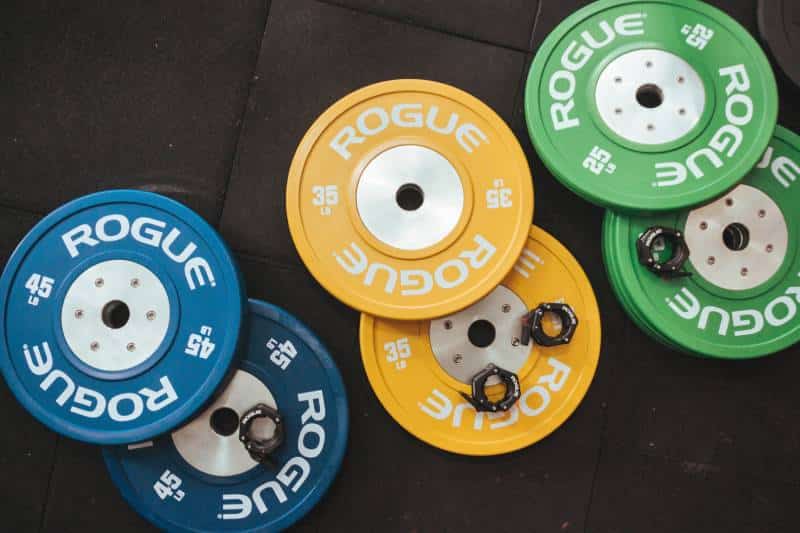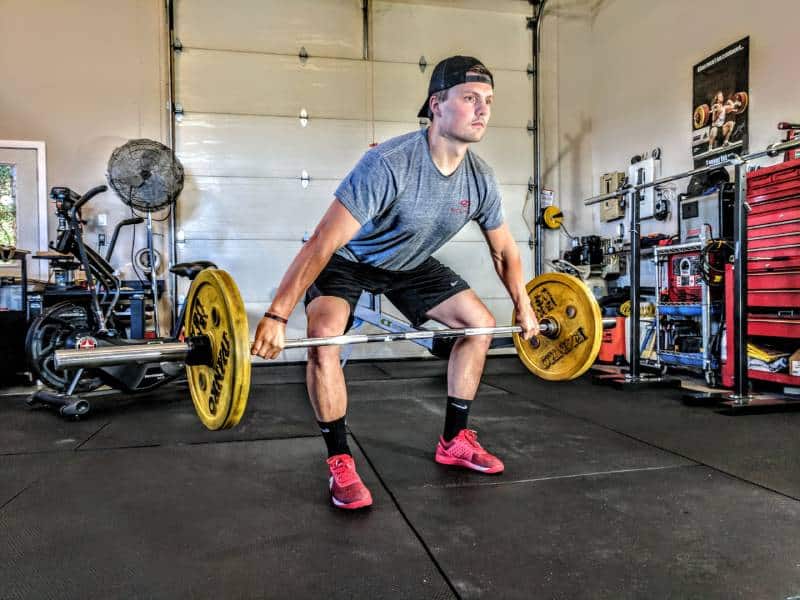If you’re new to weightlifting or strength training, the different weight colors you see on some bumper plates might be confusing. Especially if you’re thinking about investing in home gym equipment and trying to decide which weight plates to buy.
Whether you want to buy Olympic plates and understand the colors, or are just wondering the differences the colors serve, here’s everything you need to know.
Jump to:
What are the Different Weight Plate Colors?
Olympic bumper plates use specific color coding to ensure the weight loaded during competition is accurate. The colors used are red, blue, yellow, green, and white—all of which must be loaded on a loaded Olympic bar.
The kilogram denominations of weight plate colors are:
- Red – 25kg / 55.1lbs
- Blue – 20kg / 45lbs
- Yellow – 15kg / 33lbs
- Green- 10kg / 22lbs
- White – 5kg / 11lbs
What Are Color Coded Bumper Plates Made Of?
Olympic bumper plates are made with a stainless steel insert core with hard, dense rubber surrounding it. Competition bumper plates always measure 45cm in diameter and are dyed according to their weight.
You can also find lighter, fractional weight plates that are smaller and weigh as little as half a kilogram. These often follow a similar color code—the only difference is that as opposed to rubber, they’re generally made from materials like steel.

Why Do Olympic Weight Plates Have Different Colors?
The main reason is simple: to differentiate the weight plate colors during Olympic weightlifting competitions, so judges (and viewers) can accurately count how much weight is loaded on a barbell.
Any competition sanctioned by the International Weightlifting Federation requires Olympic standards for any and all equipment being used. This includes weight colors you can easily visually identify, as well as a sanctioned Olympic weightlifting bar that weighs exactly 20 kilograms for men and 15 kilograms for women.
This way, the claimed weight on the bar can easily be verified after each successful Olympic lift and a new weight can be loaded.
Does Powerlifting Use Different Color Bumper Plates Too?
The International Powerlifting Federation often uses a similar color code as a gold standard for their competitions.
However, because weights being used for squats and deadlifts can be upwards of 1,000 pounds in professional competitions, the plates may be made of iron.
At smaller local Olympic weightlifting and powerlifting competitions, you might not always see colored weight plates.

Do You Need Different Weight Plate Colors for a Home Gym?
For home gym strength training, Olympic weight plates offer some unique benefits.
For example, they have more of a dead bounce when dropped from the top of Olympic lifts like snatches or cleans, which could be good depending on the floor surface you’re lifting on.
However, unless you plan to host competitions, you don’t need color coded weight plates for a home gym. In fact, if you’re working on a limited budget and want to train the Olympic lifts, purchasing a high-quality Olympic barbell would be a wiser investment.
You can buy similar items for a home gym that cost much less. One set of Olympic weight plates tend to cost more than $500; on the other hand, you can find budget bumper plates for at least $100 cheaper, even less if they’re on sale.

Do Most Gyms Have Color Coding Weight Plates?
You’re most likely to find a competition bumper plate in Olympic weightlifting gyms, CrossFit facilities, and in functional fitness spaces inside larger commercial fitness facilities. Most gyms have a vary of weight plates for people to use.
Olympic bumper plates will most likely be located in an area with lots of floor space or Olympic platforms where barbells can safely be dropped.
Are Bumper Plate Colors the Same As Olympic Weight Plates?
Olympic bumper plates should always follow the red, blue, green, yellow, and white standard as far as colors go.
However, most bumper plate products are black (shiny or matte) and often made from recycled rubber. It’s perfectly safe to perform Olympic weightlifting exercises with any type of bumper plate.
Alternatively, you should never use iron weight plates when training Olympic lifts. Bumper plates are safer not only for you, but for the floor beneath you. You could even damage your barbell by dropping heavy weight loaded from an overhead position.















